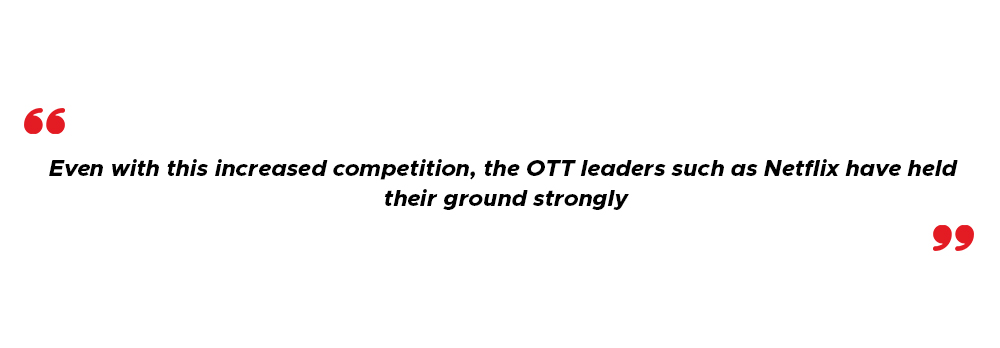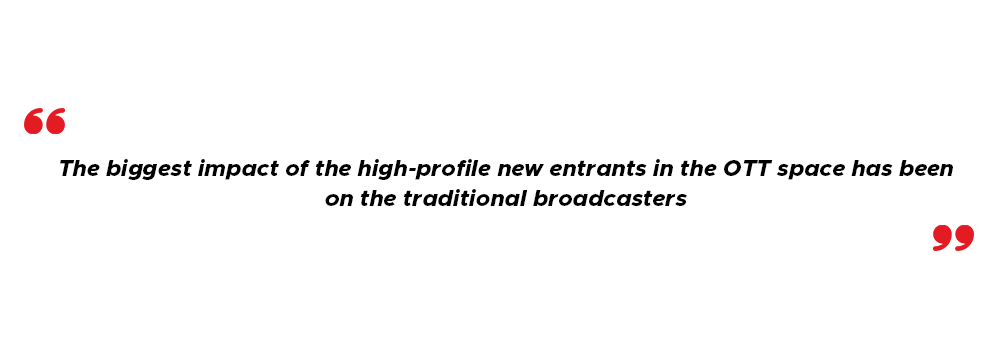Sparking a new boom in the Media & Entertainment world, streaming companies are continuously upping their game due to the nationwide Covid-led shutdowns. Established players in the industry are revamping their strategies to stay ahead of competition while new entrants such as HBO Max, Quibi and Peacock are ramping up their efforts to grab viewer’ attention.
The streaming landscape took a transformative turn when the whole world was forced to move inside their houses and search for new sources of entertainment. Presented with a diverse range of choices when it comes to streaming platforms, individuals across the globe are cutting the cord and are transitioning to streaming platforms such as Netflix, Amazon Prime Video, Hulu, Peacock, HBO Max, Disney+, CBS All Access, Apple TV+, Tubi, YouTube, Quibi, Crunchyroll, Shudder etc. One may not be paying their cable bills anymore but might have to subscribe to a bundle of OTT platforms to keep up with all the content out there. As different types of content keep switching platforms, it can take a while to understand which type of content is offered on which platform.
Streaming wars intensify
The intensification of the streaming wars over the last few months due to the launch of several high-profile OTT (SVOD) platforms can’t be ignored. A year ago, the talk was mostly around which platforms would survive alongside Netflix and Amazon Prime Video – the OTT market leaders. But the OTT landscape changed swiftly when launch plans for high profile streaming platforms started to float such as Apple TV+, Disney+, HBO Max, Peacock and Quibi. The companies had even set aside millions for marketing and promotion. The entrance of the new platforms prompted subscribers to sign up for one or more platforms.
Here’s an overview of the new entrants in the OTT space – majorly responsible for intensifying the streaming wars.

Disney+
Since its launch in November 2019 in the United States, Disney+ has been a huge success. By August 2020, the platform recorded more than 60.5 million paid subscribers, according to Bob Chapek, CEO, Walt Disney Company. Now that it has exactly been a year since its launch, Disney+ has reached a new record of 73.7 million subscribers (CNBC). The growth path has been phenomenal, considering the goal of the company, at its launch, to reach from 60 to 90 million subscribers by 2024 (CNBC).
Disney+ is quickly catching up with Netflix, which recently announced having recorded 195 million subscribers. The timing of Disney+’s European launch played a significant role in the success, as it was launched just before the Covid-19 lockdown. Viewers were already craving for more entertainment sources when the lockdown began, giving Disney+ the required momentum to succeed in Europe.
Although credit must be given to Disney’s powerful brand awareness campaign, tactical bundling (such as Disney+/Hulu/ESPN+ bundle for the US audience), helped in expanding the reach greatly.

HBO Max
Currently available only in the US, owned by AT&T and WarnerMedia as its parent company, HBO Max was launched on 27th May 2020. The VOD service automatically provides subscriptions to individuals who are subscribed to HBO, providing a jumpstart in terms of subscriptions. The company recorded 36.3 million subscribers in the US by the end of second quarter, growing slowly from 34.6 million in 2019 end (IBC). As predicted by AT&T, by 2025, the company aims to reach 50 million subscribers in the United States.
Being one of the most expensive OTT platforms in the US (subscription fee of $14.99/month), HBO Max is targeting two core goals – the first one being the “activation” of existing HBO channel through the current customers and the second – to use to the extra Warner/Tuner content to grow the audience base, especially the young families.

The content strategy of HBO Max focuses on premium content, with ample amount of high-value content for the audience to choose form. This is being built on HBO’s reputed brand image which is already associated with high-quality shows. With future plans of international expansion in South America, parts of Eastern Europe and few parts of Asia, HBO Max’s focus is on original content production to entice the audience.
Peacock
An AVOD (Advertisement video-on-demand) service, Peacock provides three subscription tiers – Free, Premium and Premium Plus. Viewers can access limited content on the platform with ads interspersed in the ‘free’ plan. In the ‘premium’ plan, viewers have access to the full content library with advertisements. In both ad-supported plans, commercials are capped at 5minutes/hour. The Premium plus plan provides access to the full content library without ads.
Experts believe that these three subscription tiers are very attractive as the advertisement load is light as compared to traditional TV, which on an average has commercials for 11 minutes/hour.
NBCUniversal had planned to launch “Peacock” alongside the 2020 Olympics but, owing to the Coronavirus pandemic, even though the Olympics had to be postponed, the company was able to launch the platform as scheduled.

Apple TV+
Apple’s multi-dollar effort to enter the streaming space is hard to analyse as the company hasn’t released any numbers yet. The service, which is freely available to anyone who purchases the new Apple iPhone or computer, provides a very narrow selection of original content.
In January 2020, a report by Ampere Analysis stated that Apple TV+ had around 33.6 million subscribers in the United States alone (IBC). Out of which, majority were enjoying the free subscription period. Apple’s biggest challenge will be to retain the customers after their free subscription ends. The limited content on the platform is going make things more difficult.
A latest survey revealed that as compared to other leading SVOD platforms, Apple TV+ is the least popular streaming service with bad quality content, no variety and worst user interface (IBC).
Impact of the streaming war on the OTT landscape
The fierce competition by the new entrants hasn’t affected the market leader Netflix as, by the end of second quarter, the company recorded nearly 200 million paid subscribers (CNBC). A study published by Piper Sandler states Netflix subscribers are most likely to remain loyal to the brand post-pandemic. Stocks of Netflix witnessed an all-time high after this survey was published. The survey also revealed that 41% of Netflix subscribers are likely to continue their subscriptions even after lockdowns get over. While on the other hand 28% of Amazon Prime Video’s subscribers would remain loyal to the brand. The long haul will be followed by 17% of Disney+ subscribers, 19% of cable TV, and 7% of HBO Max subscribers.

Disney+ has majorly attracted young adults and individuals with children therefore, the success of the platform has not impacted the big players such as Netflix and Amazon Prime Video as of yet. Similarly, for HBO Max, majority of the initial subscriber base consists of existing HBO subscribers, which again doesn’t pose a threat to the big OTT players.
The impact of the high-profile new entrants will also vary according to region. For example, the market in the Nordic countries will witness less competition as compared to others as people in that region are accustomed to stacking and have more budgets for video on demand.
It is interesting to note that the biggest impact of the high-profile new entrants in the OTT space has been on the traditional broadcasters. Due to the nationwide lockdowns, there was a surge in streaming and traditional TV viewership. While the streaming platforms kept enjoying the upward graph, traditional TV viewership declined from its peak to 3 hours 2 minutes per day, i.e. witnessing a sharp decline of 44 minutes, by June end. According to Ofcom, although broadcast TV viewing remains 11% higher than last year same time, it is comparably lower than it was in 2014-17.
The Coronavirus pandemic has lead to a change in the viewing habits and preferences of people.
SG Analytics conducted a survey of over 1,500 viewers of digital content across the US to understand viewing habits and subscriber preferences. Read the whitepaper: OTT Viewing Platforms.
Conclusion
The arrival of “streaming wars” was publicized by analysts and journalists when the legacy media & entertainment companies decided to flood the streaming video market with their own platforms. Even with this increased competition, the OTT leaders such as Netflix have held their ground strongly. The large M&E companies believe that streaming is the future. Many of these companies, including Disney, have waited too long to enter the OTT media space and are now executing strategies that will help them cannibalize their highly profitable legacy business to become successful in the streaming space. A report by PwC states that viewers will be willing to pay for only three-five streaming services.









